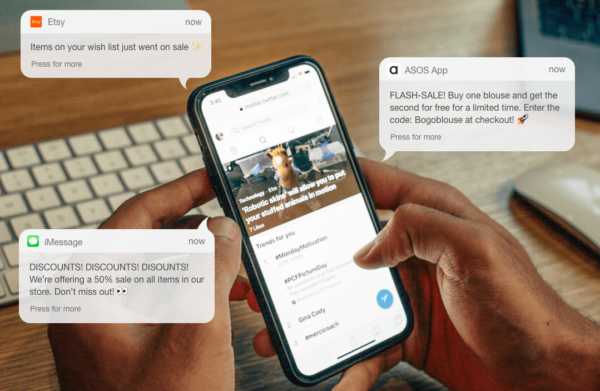
The Definitive Guide to Effective Ecommerce Discount Pricing
Employed strategically, discounted pricing can give sales a healthy boost; handled incorrectly, it can devalue and detract from the bottom line.
Many ecommerce businesses lean heavily on discount pricing to help carry their brand through difficult economic times or to drive conversions.
Take the coronavirus pandemic, for example. According to a recent McKinsey & Co survey, 40% of consumers are more mindful of where they spend their money, and 32% say they are moving to less expensive brands and products to save money.
Competing with low-priced products is hard, which is why plenty of retailers turn to discounts. On the surface, this seems to be the right thing to do, especially when 60% of US consumers say discounts are more important to them while shopping online since the start of the coronavirus pandemic.
But while discounted pricing can certainly boost your conversion rate, it lowers returns on each conversion, lowers average order values, and can end up causing real revenue to decline.
I know how you feel – darned if you do, and darned if you don’t.
There are times when discount pricing can pay off, and there are times when it can hurt you a whole lot more than it helps. In this guide, I’m going to show you how to decide when and how strategic discount pricing can make sense, and when it doesn’t.
We’ll cover the types of discount pricing, the psychology behind discount pricing, how to develop a winning discount pricing strategy, advantages and disadvantages, and show you some examples of discount pricing in action.
After that, we’ll talk about how to compete (and win) against a competitor’s discount pricing campaign. In other words, this is a full-spectrum guide ecommerce managers can use to know when, how, and why to pull discount pricing out of the tool box.
What is a discount pricing strategy?
Discount pricing is a strategy often used to generate more sales – typically by dropping the prices you ask for your goods or services. However, discounting too much or too often can eat into your bottom line revenue and do major damage to your brand.
That’s why it’s essential to understand the fundamentals of discount pricing strategies, including the advantages and disadvantages that accompany them.
The common types of discount pricing
Discount pricing typically falls into one of seven basic categories. Understanding these categories can help you determine whether a discount campaign is appropriate for your situation at any given time.
- Volume discounts: The more you buy, the less it costs. Quantity discounts can convince customers to purchase in bulk. Loyalty programs and cards that give a free item after a certain number of items are purchased can be another way to approach volume discounts while bundling items together.
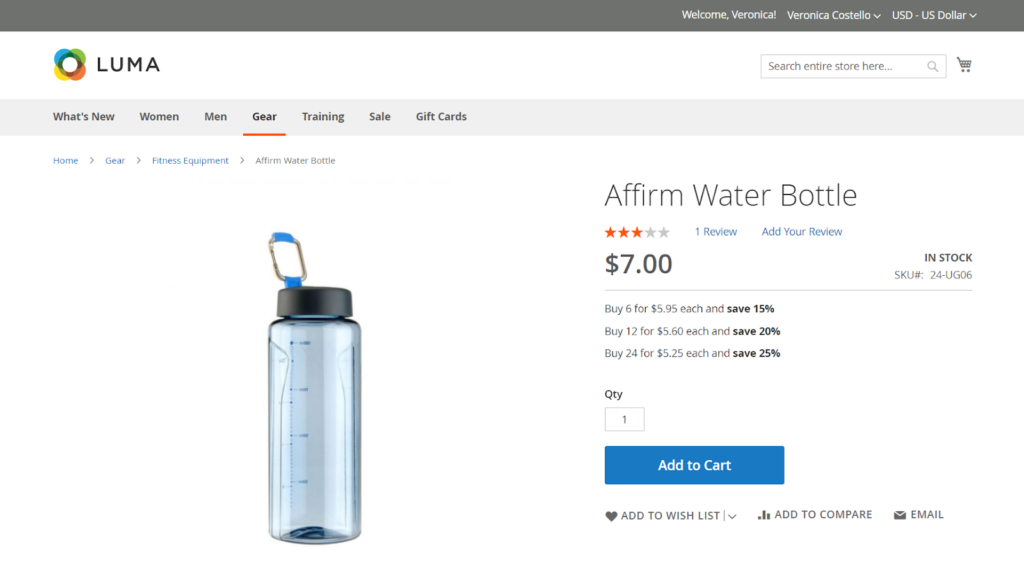
Luma gives a 15% discount for customers that buy six water bottles, 20% for customers that buy 12, and 25% for those that purchase 24.
- Seasonal discounts: These are an excellent way to jumpstart sales at the beginning of peak seasons or reward customers who purchase during dormant times. Offering discounts based on the time of year can not only generate excitement, but can help you clear out the previous season’s inventory to prepare for the coming season.
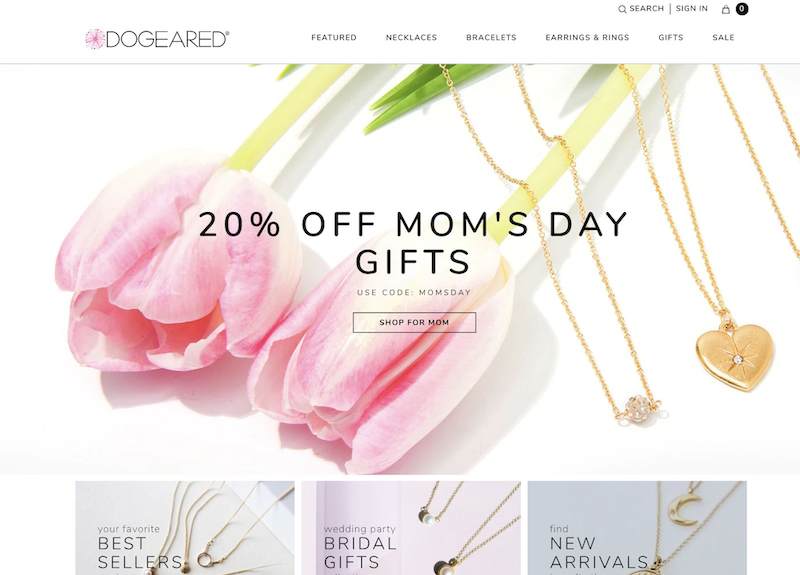
Dog Eared gives customers 20% off around Mother’s Day.
- Promotional discounts: Keep them short-term and aimed at driving a special sale. This is the type of discount you don’t want to leverage recklessly. Promotions that occur too frequently can signal your customers not to order from you until there’s another promotion. Consumers expect holiday sales, so don’t be afraid to jump on that bandwagon… just be careful about making promotions a major part of your sales strategy.

Boohoo is renowned for hosting promotional sales almost every single day.
- BOGO sales: You’ll want to check local laws on this one. BOGO offers (buy one get one) often claim the second item is “free.” If you must buy something to get something, though, you’re really getting a 50 percent discount, not a “free” item. Be sure to describe the BOGO accurately and either spell out the real savings or make them easy to calculate.

Simcha’s offers a BOGO deal on their women’s and children’s winter clothing.
- Loyalty discounts: This can be an amazingly effective way to build the bond between you and your best customers. Be clear on the terms and make sure the discount really is ONLY for those who qualify – whether by being a repeat customer, a longtime customer, a membership customer, or other status definer. Make your customers feel special, and they’ll make sure you stay in business.

Jane’s Boutique gives returning customers 30% off their next purchase.
- Membership discounts: These can be reserved for card-holding members of your private club (Amazon Prime members, for example), for members of someone else’s club (AARP), or for those who qualify by being a military veteran, a senior citizen, or some other designator. Just as with loyalty discounts, showing appreciation for your customers is always a good idea.
The psychology of discounting
It’s easy to think that discounting was a byproduct of online shopping. The increase in competition and the need for instant gratification has definitely seen the number of brands using discounts soar, but the strategy has been around for a lot longer.
In fact, it was Coca Cola that started the trend. They were the first company to lure in customers with discounts as far back as 1887. Customers could use a coupon to redeem a free glass of Coke – so simple, but such a huge leap for the retail world.
Today, it’s no secret that there are psychological principles at work in the buying and selling process. Most have heard of Dr. Robert Cialdini’s book, “Influence: The Psychology of Persuasion,” but Cialdini didn’t invent the ideas covered there. He simply collected and codified them.
Discount pricing comes with its own set of psychological touchpoints:
- Classical Conditioning: Offering promotional discounts too frequently can train your audience to wait for promotions before they’ll buy from you.
- Perception of Quality: One of the reasons people buy a luxury new product is to get better quality (or at least the perception of quality). A product that costs $399 looks ‘inferior’ to the similar product priced at $600. Discounting can lower the perceived quality of your goods.
- Scarcity: Discounts tied to urgency are usually more effective. When the consumer is faced with “Buy now or lose the opportunity,” the decision is often swayed towards placing the order immediately.
- Social Influence: Most people like to brag about getting a “good deal.” Those who get a generous discount on something feel smarter than the neighbor who paid full price and won’t be shy about letting others know about the transaction.
- Perception of Savings: Comparisons help make your case. Don’t just list something at a 25 percent discount. Give the “normal” price, slash through it, and state the current price. If you’re going to discount something, make it dramatic!
- Be careful about how you display the discount. A rule of thumb (for instance) is that buyers respond better to percentage discounts (e.g. “20 percent off”) for items priced under $100 but prefer seeing absolute value discounts (e.g. “Save $20) when the item is over $100. Being sure to show the original price, stricken out, with the new discounted price next to it, can also be helpful.
- Exclusivity: Justify your discounts. Always have a reason. Whether it’s the end of summer, you’re passing on a special price you arranged from the manufacturer, or today is your dog’s birthday… make sure to announce WHY you’re discounting. Otherwise, your customers may think your profit margins are so high that you can afford to discount everything all of the time.
Discount strategies and tactics: Top-performing discounts you can use today
Look around every corner and you’ll come across a new discount pricing strategy in play. It’s almost become second nature for consumers to expect a discount after their first purchase or get money off at a big sales event like Black Friday or Cyber Monday.
Enjoying this article?
Subscribe to our newsletter, Good Question, to get insights like this sent straight to your inbox every week.
Here are some of the most common discount strategies in the ecommerce world:
1. Discount codes
Discount codes are digital money-off vouchers that customers can enter when making a purchase.
There are a slew of websites around today that scrape discount codes from sites and offer them to shoppers for free. This means that nine times out of ten, a customer will be able to find a discount code for a brand they want to buy from (and, if not, there will definitely be a discount code for a competitor).
Discount codes can be created for multiple different reasons:
- To give specific customers a chance to get money off (i.e. first time buyers or those born in August)
- To celebrate a specific event
- To give to influencers to share with their audiences
- To promote a specific line of products

Gap offers customers 25% off for the brand’s birthday with a specific discount code.
2. Abandoned cart discount
The average abandoned shopping cart rate is 69.80%, which means almost 70% of customers walk away empty handed from your online store. Abandoned cart discounts lure customers back with the promise of money off if they complete their order.
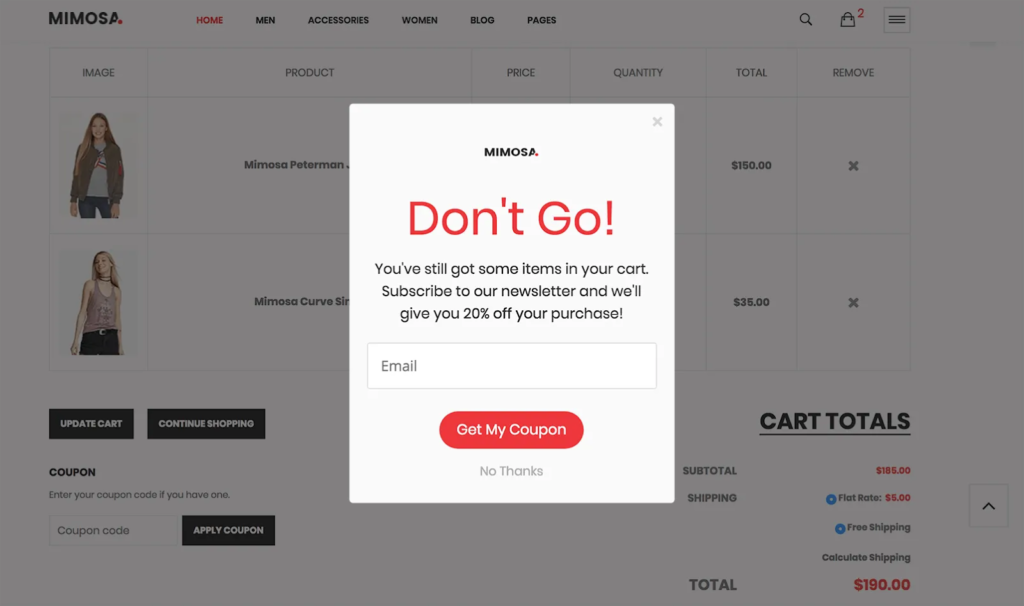
Mimosa catches customers before they leave by offering a discount if they subscribe and complete their purchase.
3. Flash sales
Big shopping events like Black Friday and Cyber Monday are rife with flash sales. Customers can get discount pricing on a huge amount of products for a limited time – but there are flash sales that are even shorter than this, running for six hours, three hours, or even one hour in some cases.
Flash sales like this tap into the sense of urgency and FOMO we spoke about earlier, compelling on-the-fence customers to take the plunge and hit the buy button.

Rue Lala offers all its products for a reduced price in a 48 hour flash sale.
4. Free gift with purchase
Getting a freebie with a purchase isn’t so much a discount, but the customer is getting something for free which sweetens the deal. This tactic is often used on first-time customers who can claim their free gift after making their first order.

Applecrumby Fish gives customers the chance to unlock a free gift when they buy a specific product.
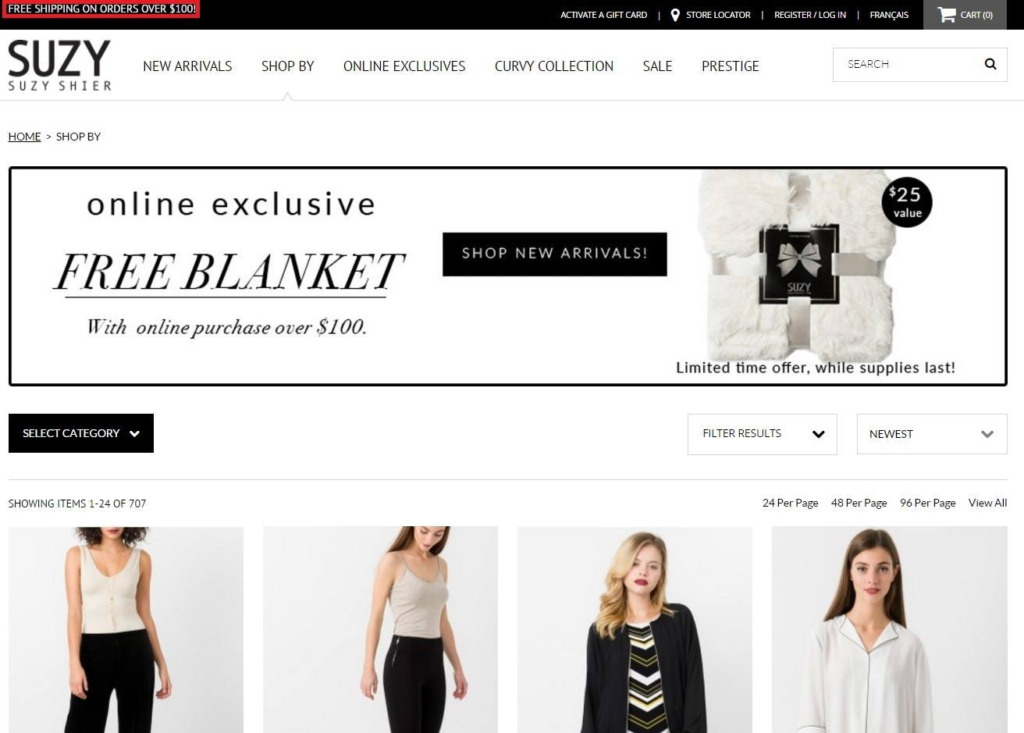
In another example, Suzy Shier offers customers a free blanket when they spend over a certain amount.
5. Free shipping if you spend over X
Again, this isn’t so much a discount but an incentive for customers who might be on-the-fence. According to research, nine out of 10 customers say free shipping is the top incentive when buying online, while 93% of consumers will buy more if free shipping options are available.
This tactic lets shoppers unlock free shipping if they spend over a certain amount or buy a certain number of products, increasing their AOV.

Hint gives customers free shipping when they buy three or more items.
6. First-time customer discount
Offering customers a first-time buyer discount is almost a rite of passage these days. It’s a key way merchants get shoppers on their email lists, and gives potential buyers the chance to try out a brand and its products for a reduced rate.
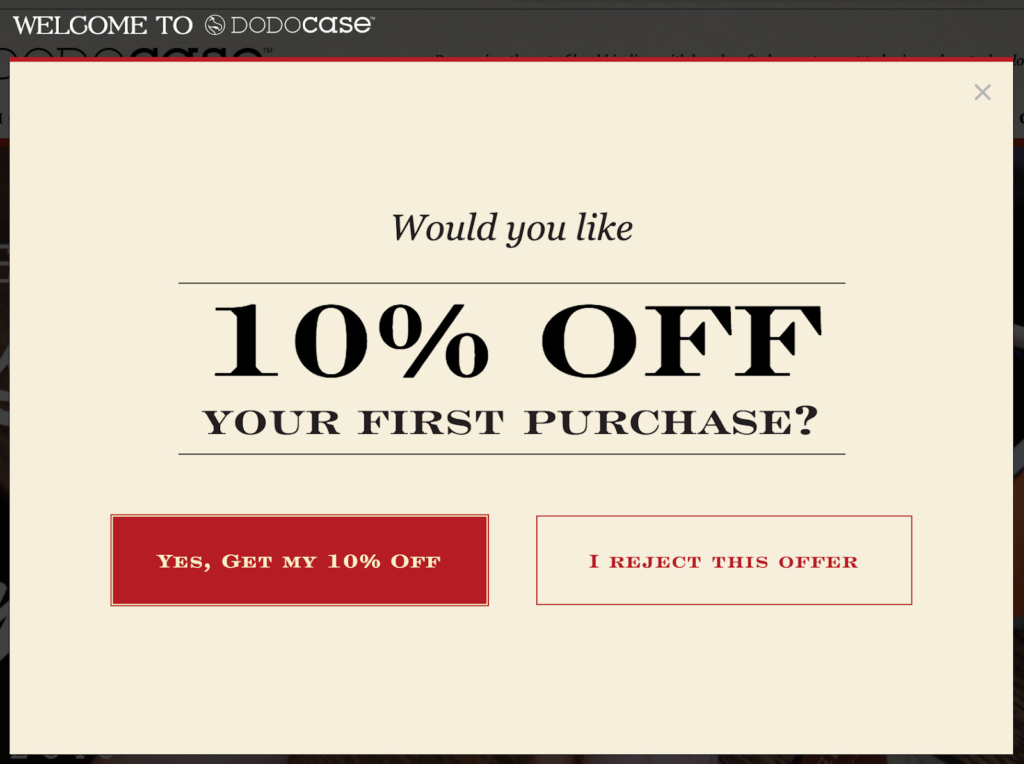
Dodo Case uses a pop up to ask new visitors if they want to claim a 10% discount.
7. Tiered discounts
The more money a customer spends, the more money they can save. This is the mindset behind tiered discounts, where percentages increase along with a customer’s cart total.

Boll & Branch start by offering customers $25 off if they spend over $150.
Ecommerce discount pricing – bad idea or good idea?
Incentivizing customers can seem like the right thing to do, and adding a discount code is the default way of doing this. But, while it might boost your sales numbers quickly, it can come with some serious tradeoffs.
“But everyone is discounting!”
Sure, but that’s because they’re essentially hitting the easy button, not trying to find the best way to boost sales numbers, increase revenue, and instill brand loyalty.
That’s not to say you should never offer discounts. We’re simply saying that there are better ways to incentivize purchases, like increasing the value your customer receives rather than slashing your prices.
Discounts give every instant gratification, but they can lead to detrimental long term effects like:
- Drained margins
- Lower customer lifetime value
- Higher revenue churn rates
- Attracting less-than-ideal customers
Discounts definitely aren’t always bad. They can secure a high customer lifetime value on items that require repeat purchases, and they can be a great way to attract a new surge of customers once or twice a year.
Discount pricing strategy pros and cons
To help you determine whether a discount is right for you or whether you need to dig deeper to add value to your offerings, here are the pros and cons of discount pricing.
The advantages of discount pricing
- Discounts not only appeal to current customers but attract new customers. If you’ve computed the lifetime value each new person adds to your business, it’s easy to see where giving up a chunk of your profit (or even losing money) for one sale is worth it in the long run.
- Discounts present the perfect opportunity to offer cross-sells and upsells that can more than make up for the money you forfeited by providing the discount.
- Discount pricing promotes brand recognition for great prices delivered. If you develop a reputation as not only being the place to find a great selection of tents and sleeping bags – but also the place where shoppers can find great prices – you’ve tapped into some word-of-mouth magic.
One more time: if you discount too frequently, you can train customers to buy from you only when the price is reduced. You’ll end up looking like the store that’s been holding a “Going out of business” sale for years. Eventually, you’ll lose credibility. Customers will stop feeling a sense of urgency. They’ll quickly figure out that all they have to do is wait for the next discount. They’ll begin to think that everything is always marked down.
The disadvantages of discount pricing
Discounts can also be the starting point of a downward pricing spiral that may eventually damage your ability to sell the product at full price.
The disadvantages of discounting are serious enough that any ecommerce manager considering launching a discount campaign should think well on the idea before proceeding. Once your company’s reputation moves from quality and service to low price leader, you’ll be drawing a whole new crowd and experiencing a whole different set of problems.
The cost of discounting: competing against discount pricing
Companies often get unwittingly pulled into a price war with the competition. Perhaps management doesn’t really want to discount, they just see no other way of responding to the advertised price cuts by others.
Here’s how to hold your ground:
- Highlight your value proposition. What differentiates you? Why is buying from you the best choice – price aside? When others lowball to gain business, your best bet may be to hold your ground and point out the obvious: low price seldom means the best value.
- Focus on providing a better customer experience. Be more helpful than competitors. Provide better service. Let your audience know you’re in it for the long run, not to make a quick buck.
- Use the foundational principles of optimization to increase sales. Discount pricing is just one way to obtain customers, and it’s usually not the best way. Optimization can shore up your sales without resorting to dropping your prices.
If you choose to employ discount pricing strategies and tactics, make sure your decision comes from a reasonable plan of action. Much of the time, discounting is based on reaction to the path others have chosen. Let the competition price itself right out of business. Just don’t follow them.
How to add value to your discounts
Don’t just follow the crowd when it comes to discounts and run sales for the sake of it. Instead, add value to your promotions to attract the right kind of customers and keep them coming back for more.
1. Define what you want to achieve
Think about what you want to achieve with your discount strategy. Do you want to:
- Improve customer acquisition
- Increase sales
- Earn repeat customers
- Get rid of unsold inventory
When you know what results you want to get, it’s easier to decide what type of discount to run or whether running a discount is the right thing to do. If you simply want to get rid of unsold stock, a flash sale can work wonders, but there might be a more strategic way to reach new customers.
2. Discount the right products
Not everyone is going to jump at the chance to get your worst selling product at a reduced rate (there’s a reason it’s not shifted off the shelves yet, after all). Instead, think about your most successful products and whether a discount is the right way to go.
For example, don’t run BOGO sales on an exclusive product that customers aren’t going to want or need two of. On the flipside, do discount products that are fitting with the season, like academic books in the lead up to the new school year.

3. Be strategic with your marketing
Where will you shout about your discount? Do you want everyone to have access to it or just a select few? Make sure the right people see it by sharing it in your email marketing campaigns, on the front page of your website, and relevant social media channels.
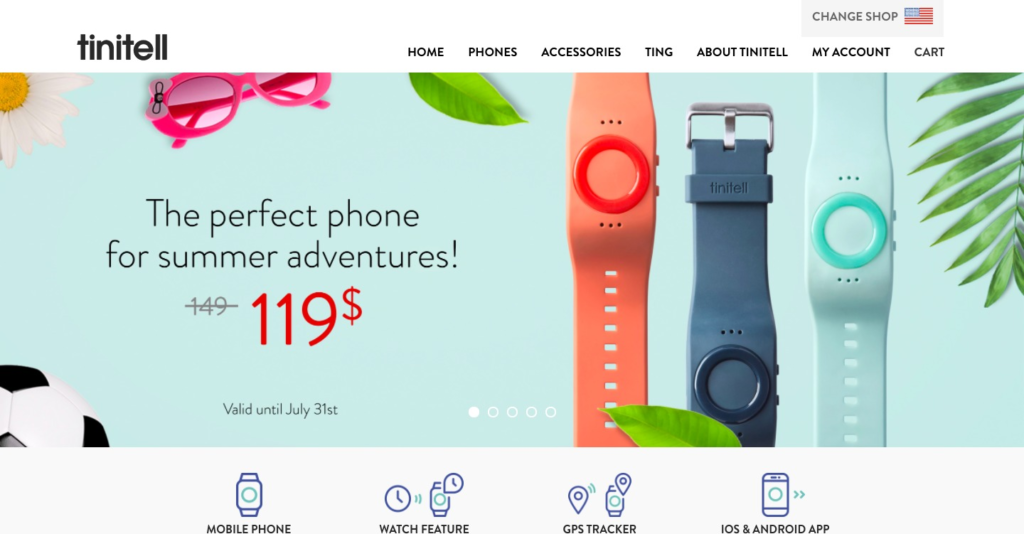
Tinitell splashes their discount across their homepage with an eye-catching design.
Do you really need to discount?
Before you hit “go” on your discount pricing campaign, stop and think.
Will offering a discount help you reach your goals? Are you just doing it because everyone else is? What other strategies could you use that will get similar results?
Discount pricing, handled incorrectly, can lead to the devaluation of your products in your customers’ eyes and teach buyers to wait for the next sale before purchasing from your ecommerce website. Discount pricing, done right, can help you launch special events and give sales a healthy boost. The difference is all in the planning. Before discounting, read back through this guide to check your motives. Look beyond the immediate impact of the tactics you’re about to employ to the potential after-effects.
Never employ discounts if your brand will suffer in the long term. When sales are so bad you feel forced to turn to discounting prices in order to stay afloat, your problems are much deeper than your pricing strategy.
Enjoying this article?
Subscribe to our newsletter, Good Question, to get insights like this sent straight to your inbox every week.

About the Author
Jon MacDonald
Jon MacDonald is founder and President of The Good, a digital experience optimization firm that has achieved results for some of the largest companies including Adobe, Nike, Xerox, Verizon, Intel and more. Jon regularly contributes to publications like Entrepreneur and Inc.